2003 Edwards AFB
Open House
Static Displays, October 24
|
(Download a higher resolution picture by clicking on any
picture below.)
 The Edwards
Air Force Base Open House was held the weekend of October 25-26.
During the two-day event, visitors saw new and unique aircraft in
the Air Force inventory, and some of the best aerial
demonstration pilots and teams performing today. The various
demonstrations included Air Force aircraft such as the F/A-22,
F-117, F-16, KC-135, C-17, B-1, which set 52 official world
records, B-2, as well as NASA aircraft among others. This was
also a once-a-year opportunity for taxpayers to see the kind of
equipment they buy for the Air Force, and the abilities of the
people who test, fly and maintain this equipment.
The Edwards
Air Force Base Open House was held the weekend of October 25-26.
During the two-day event, visitors saw new and unique aircraft in
the Air Force inventory, and some of the best aerial
demonstration pilots and teams performing today. The various
demonstrations included Air Force aircraft such as the F/A-22,
F-117, F-16, KC-135, C-17, B-1, which set 52 official world
records, B-2, as well as NASA aircraft among others. This was
also a once-a-year opportunity for taxpayers to see the kind of
equipment they buy for the Air Force, and the abilities of the
people who test, fly and maintain this equipment.
The static display aircraft were arrayed on the flightline
Friday afternoon as the United States Air Force Thunderbirds
arrived.
Vintage Aircraft:
 Wright Flyer replica. It doesn't
get more vintage than that.
Wright Flyer replica. It doesn't
get more vintage than that.
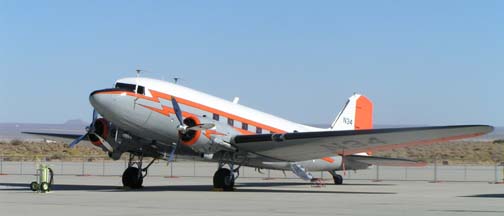 Douglas DC-3C, N34 is registered to
the FAA. Its Douglas construction number is 33359. Sadly, the
Smithsonian Institution will soon ground this beautifully
restored airplane.
Douglas DC-3C, N34 is registered to
the FAA. Its Douglas construction number is 33359. Sadly, the
Smithsonian Institution will soon ground this beautifully
restored airplane.
Link to the DC-3/Dakota
Historical Society Page about N34.
 Curtiss C-46F Commando, N53594 China
Doll of the Southern California Wing of the CAF.
Curtiss C-46F Commando, N53594 China
Doll of the Southern California Wing of the CAF.
Link to the web site of the Southern
California Wing of the Commemorative Air Force.
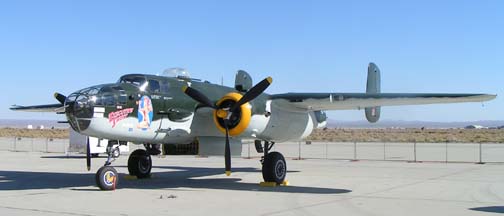 North American B-25J Mitchell,
N30801 Executive Sweet . It
has been registered to the American Aeronautical Foundation of
Thousand Oaks since 1985. Its Army Air Force serial number was
44-30801 and its North American construction number is 108-35126.
It was converted to the TB-25N configuration before its
retirement by the Air Force. It was registered as N3699G by Avery
Aviation of Greybull, Wyoming in 1963. Filmways Inc. of Hollywood
acquired it in 1968 for use in the movie Catch-22.
Challenge Publications bought it in 1972 and changed its
registration to N30801 in 1978.
North American B-25J Mitchell,
N30801 Executive Sweet . It
has been registered to the American Aeronautical Foundation of
Thousand Oaks since 1985. Its Army Air Force serial number was
44-30801 and its North American construction number is 108-35126.
It was converted to the TB-25N configuration before its
retirement by the Air Force. It was registered as N3699G by Avery
Aviation of Greybull, Wyoming in 1963. Filmways Inc. of Hollywood
acquired it in 1968 for use in the movie Catch-22.
Challenge Publications bought it in 1972 and changed its
registration to N30801 in 1978.
Link to the web site of the American Aeronautical Foundation.
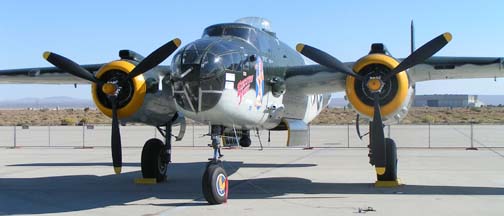 North American B-25J Mitchell,
N30801 Executive Sweet.
North American B-25J Mitchell,
N30801 Executive Sweet.
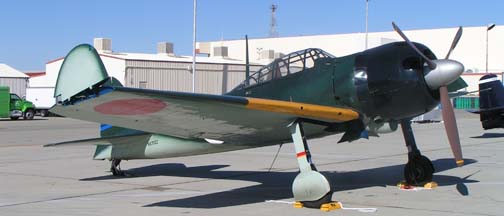 Mitsubishi A6M Zero, NX712Z of the
Southern California Wing of the CAF.
Mitsubishi A6M Zero, NX712Z of the
Southern California Wing of the CAF.
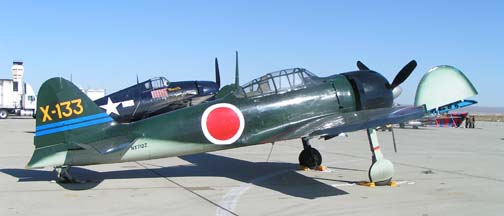 Mitsubishi A6M Zero, NX712Z of the
Southern California Wing of the CAF.
Mitsubishi A6M Zero, NX712Z of the
Southern California Wing of the CAF.
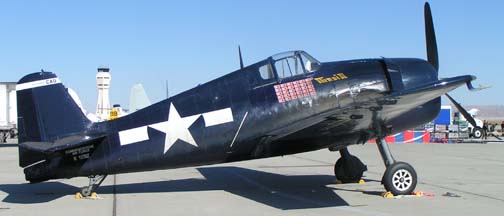 Grumman F6F-5 Helcat, N1978Z Minsi
III of the Southern California Wing of the CAF.
Grumman F6F-5 Helcat, N1978Z Minsi
III of the Southern California Wing of the CAF.
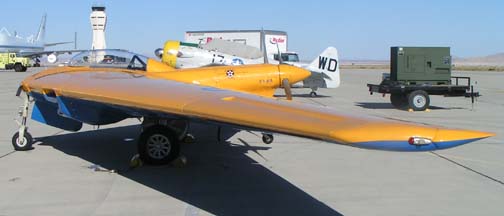 Northrop N-9MB Flying Wing, N9MB from the Planes of Fame Museum
at Chino.
Northrop N-9MB Flying Wing, N9MB from the Planes of Fame Museum
at Chino.
Link to the web site of the
Planes of Fame Air Museum.
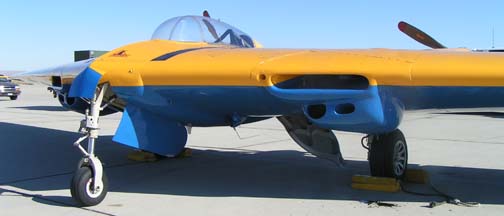
 North American SNJ-5 Texan, N89014 carries Navy BuNo 84865. It
was built in 1943.
North American SNJ-5 Texan, N89014 carries Navy BuNo 84865. It
was built in 1943.
 Beech T-34A Mentor, N12253 was built in 1955.
Beech T-34A Mentor, N12253 was built in 1955.
 North American T-28C Trojan, N653DB flew for
the Navy as BuNo 140653. It was built in 1957. It entered the
civil register as N10260.
North American T-28C Trojan, N653DB flew for
the Navy as BuNo 140653. It was built in 1957. It entered the
civil register as N10260.
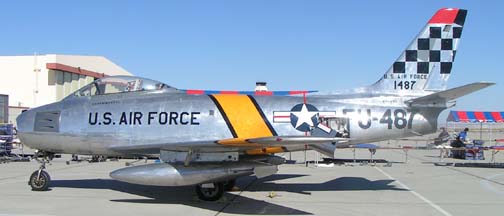 Canadair Sabre Mk.6, N38453 is owned by Al Hansen. It flew for
the South African Air Force as #378. It was registered by Flight
Systems in October 1983 and then to Global Aerospace of Newport
Beach, California in September 1992.
Canadair Sabre Mk.6, N38453 is owned by Al Hansen. It flew for
the South African Air Force as #378. It was registered by Flight
Systems in October 1983 and then to Global Aerospace of Newport
Beach, California in September 1992.
Link to Duncan's
F-86 Sabre web site page about Flight Systems Sabres.
There were several jet trainers manufactured in other
countries on the flightline.
 Canadair CT-133A Silver Star, N306CW is owned
by Wallasch Aviation, Inc of Acton, California. It was built in
1955.
Canadair CT-133A Silver Star, N306CW is owned
by Wallasch Aviation, Inc of Acton, California. It was built in
1955.
 Russian MiG-15 UTI Mongol, N41125 has been owned by Thomas Smith
of Granada Hills, California since 1996. It was built in 1954.
Russian MiG-15 UTI Mongol, N41125 has been owned by Thomas Smith
of Granada Hills, California since 1996. It was built in 1954.
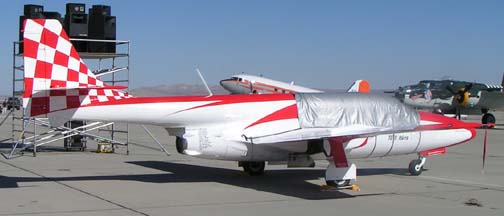 Polish WA PZL/WSK
MIELEC TS-11 Iskra.
Polish WA PZL/WSK
MIELEC TS-11 Iskra.
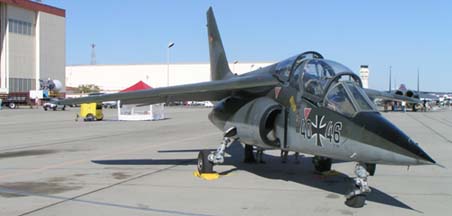 German Dornier
Alpha Jet, N46XA is owned by Richard Sugden of Wilson, Wyoming.
German Dornier
Alpha Jet, N46XA is owned by Richard Sugden of Wilson, Wyoming.

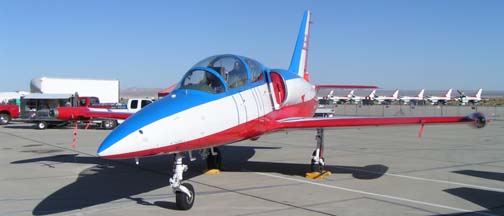 Czech Aero Vodochody L-39 Albatross.
Czech Aero Vodochody L-39 Albatross.
NASA Aircraft:
 NASA's Boeing NB-52B Stratofortress
mothership, 52-0008 was displayed on the flightline while their
new blue and white NB-52H was tucked away behind the big hangar.
NASA's Boeing NB-52B Stratofortress
mothership, 52-0008 was displayed on the flightline while their
new blue and white NB-52H was tucked away behind the big hangar.

 The old X-15 pylon and the X-43A
Hyper-X adapter on NASA's Boeing NB-52B Stratofortress
mothership, 52-0008. The history of the mothership's launches is
recorded in symbols on the side of the fuselage. The NB-52B is still
needed for the X-43A program. The wing of NASA's
NB-52H will have to be modified before it can support the weight of the
Hyper-X launch vehicle.
The old X-15 pylon and the X-43A
Hyper-X adapter on NASA's Boeing NB-52B Stratofortress
mothership, 52-0008. The history of the mothership's launches is
recorded in symbols on the side of the fuselage. The NB-52B is still
needed for the X-43A program. The wing of NASA's
NB-52H will have to be modified before it can support the weight of the
Hyper-X launch vehicle.
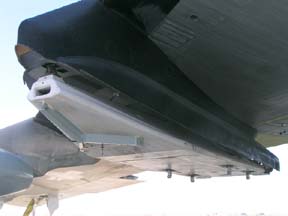 The old X-15 pylon and the X-43A
Hyper-X adapter on NASA's Boeing NB-52B Stratofortress
mothership, 52-0008. The next launch of the X-43A is anticipated
in a few months. The first X-43A tumbled out of control shortly
after launch in June 2001 "because the vehicle's control
system design was deficient in several analytical modeling areas,
which overestimated the system's margins". In other words,
project management neglected to fully model the control system's
response to the increase in dynamic pressure resulting from
launch of the Orbital Sciences booster at half the usual
altitude.
The old X-15 pylon and the X-43A
Hyper-X adapter on NASA's Boeing NB-52B Stratofortress
mothership, 52-0008. The next launch of the X-43A is anticipated
in a few months. The first X-43A tumbled out of control shortly
after launch in June 2001 "because the vehicle's control
system design was deficient in several analytical modeling areas,
which overestimated the system's margins". In other words,
project management neglected to fully model the control system's
response to the increase in dynamic pressure resulting from
launch of the Orbital Sciences booster at half the usual
altitude.
Link to the Goleta Air & Space Museum's
display about the first mission of the X-43A Hyper-X 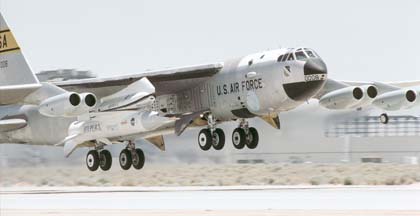 .
.
Link to the NASA Dryden page of NB-52 Mothership photos.
Link to the NASA Dryden fact sheet about the NB-52
Mothership.
Link to the NASA Dryden page of X-43A Hyper-X photos.
Link to the NASA Dryden news release about the cause
of the loss of the first X-43A Hyper-X.
 NASA Boeing 747-Shuttle Carrier
Aircraft, N905NA and a Beech T-34 Mentor. The 747-SCA may see more
frequent use if NASA decides to land the Space Shuttle at Edwards AFB
when they return to flight.
NASA Boeing 747-Shuttle Carrier
Aircraft, N905NA and a Beech T-34 Mentor. The 747-SCA may see more
frequent use if NASA decides to land the Space Shuttle at Edwards AFB
when they return to flight.
 NASA Boeing 747-Shuttle Carrier
Aircraft, N905NA.
NASA Boeing 747-Shuttle Carrier
Aircraft, N905NA.
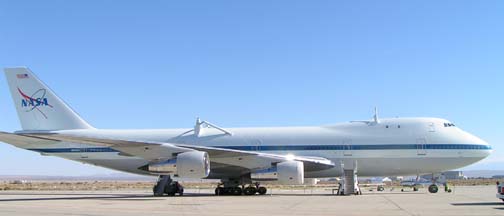 NASA Boeing 747-Shuttle Carrier
Aircraft, N905NA.
NASA Boeing 747-Shuttle Carrier
Aircraft, N905NA.
Link to the NASA Dryden page of Space Shuttle (STS) SCA Ferry
Photos.
 NASA McDonnell-Douglas F/A-18A
Hornet N853NA Active Aeroelastic Wing (AAW). It carries Navy BuNo
161744.
NASA McDonnell-Douglas F/A-18A
Hornet N853NA Active Aeroelastic Wing (AAW). It carries Navy BuNo
161744.
Link to the NASA Dryden fact sheet about the F/A-18A
Active Aeroelastic Wing.
Link to the NASA Dryden page of F/A-18A Active
Aeroelastic Wing Photos.
Link to the NASA Dryden press release about the first
flight of the F/A-18A Active Aeroelastic Wing
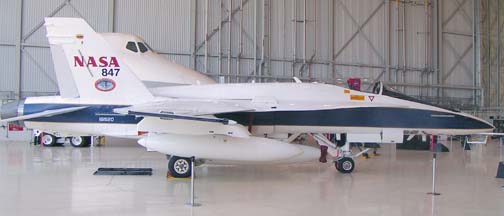 NASA McDonnell-Douglas F/A-18A Hornet N847NA is
used to research Automated Aerial Refueling (AAR) methods for
unmanned air vehicles. It carries Navy BuNo 161520.
NASA McDonnell-Douglas F/A-18A Hornet N847NA is
used to research Automated Aerial Refueling (AAR) methods for
unmanned air vehicles. It carries Navy BuNo 161520.
Link to the NASA Dryden research update about Automated
Aerial Refueling.
Link to the NASA Dryden page of Automated Aerial Refueling
Photos.
Link to the NASA Dryden press release about Automated
Aerial Refueling.
 Orbital
Sciences X-34 Reusable Rocket Technology Demonstrator.
Orbital
Sciences X-34 Reusable Rocket Technology Demonstrator.
"The X-34 is
one of NASA's new technology demonstrator programs that will pave
the way to lower launch costs." Why doesn't it say
NASA on the rocket?
The planned capabilities of the X-34:
Readily enable integration of
new technologies
Capable of 25 test flights
over a period of one year
Capable of autonomous flight
operations
Capable of demonstrating safe
abort
Demonstrate technologies
throughout flight profile
Subsonic and hypersonic
flight
Capable of powered flight to
at least 250 kft
Capable of eventually
attaining Mach 8
Demonstrate or be upgradable
to advanced RLV technologies
Incorporate some composite
structures (aero, prime airframe and thrust structures)
Composite propellant tanks
and cryo insulation
Composite lines, ducts,
valves
Advanced operable TPS
including leading edge materials
Advanced low cost avionics
(GPS/INS)
Rapid low cost flight
software development tools
Integrated vehicle health
monitoring
Capable of attaining average
recurring flight cost
Adaptable as a low Mach
number test bed (embedded, attached, or deployed) e.g..,
RBCC; Plug Nozzle; Pulse detonation wave; dual expansion
engine
The X-34 Reusable Rocket program was cancelled along with the
X-33 Single-Stage-To-Orbit demonstrator in March 2001.
Perhaps NASA
should have displayed a model of the X-33, the X-30 National AeroSpace
Plane and the X-38 Crew Return Vehicle along with the X-34. The X-30
had depended on undeveloped SCRamjet technology. The X-33 had
depended on undeveloped composite structures technology. The X-34
had depended on the undeveloped LOX / kerosene fueled Fastrac
rocket engine. It was decided that the X-38 cost too much,
limiting the crew of the ISS to the two people that can be
carried in the Soyuz lifeboat.
Link to the Federation of American Scientists page about the
X-34.
Link to the NASA Marshall Space Flight Center Fact Sheet
about the X-34.
Link to the Space.com article about the cancellation of
the X-33 and X-34.
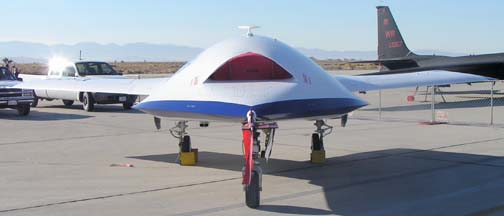 X-45A Unmanned Combat Air Vehicle (UCAV).
X-45A Unmanned Combat Air Vehicle (UCAV).
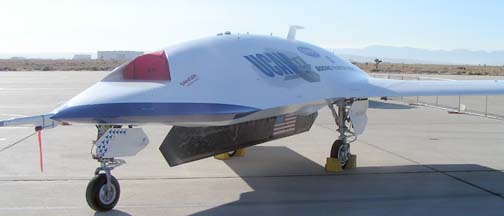 Its flights are recorded as silhouettes on the nose landing gear door.
Its flights are recorded as silhouettes on the nose landing gear door.
Link to the NASA Dryden project summary about the X-45
UCAV.
Link to the NASA Dryden page of X-45 UCAV Photos.
Link to the Boeing Phantom Works page about the X-45 UCAV.
Link to the Air Force Technology Project Page about the
X-45 UCAV.
More 2003 Edwards Air Force Base Open House Pages:
 Rehearsal,
October 22, Page 1
Rehearsal,
October 22, Page 1
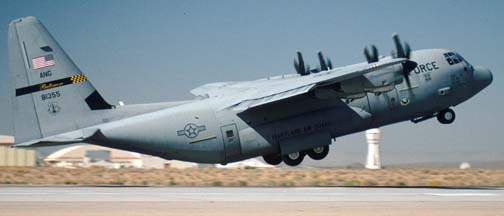 Rehearsal,
October 22, Page 2
Rehearsal,
October 22, Page 2
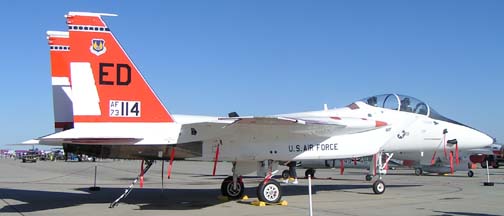 Military
Aircraft Static Displays, October 24
Military
Aircraft Static Displays, October 24
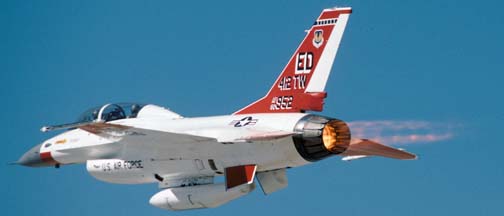 Airshow,
October 25, Page 1
Airshow,
October 25, Page 1
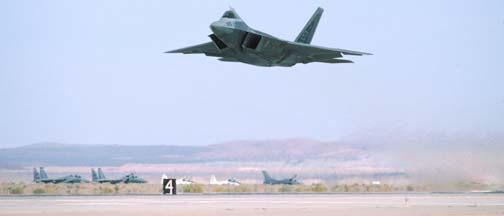 Airshow,
October 25, Page 2
Airshow,
October 25, Page 2
 Thunderbirds
Thunderbirds
Go to the Airshow Page of the
Goleta Air and Space Museum.
Go to the home page of the Goleta Air
and Space Museum.
Send a message to Brian.
 The Edwards
Air Force Base Open House was held the weekend of October 25-26.
During the two-day event, visitors saw new and unique aircraft in
the Air Force inventory, and some of the best aerial
demonstration pilots and teams performing today. The various
demonstrations included Air Force aircraft such as the F/A-22,
F-117, F-16, KC-135, C-17, B-1, which set 52 official world
records, B-2, as well as NASA aircraft among others. This was
also a once-a-year opportunity for taxpayers to see the kind of
equipment they buy for the Air Force, and the abilities of the
people who test, fly and maintain this equipment.
The Edwards
Air Force Base Open House was held the weekend of October 25-26.
During the two-day event, visitors saw new and unique aircraft in
the Air Force inventory, and some of the best aerial
demonstration pilots and teams performing today. The various
demonstrations included Air Force aircraft such as the F/A-22,
F-117, F-16, KC-135, C-17, B-1, which set 52 official world
records, B-2, as well as NASA aircraft among others. This was
also a once-a-year opportunity for taxpayers to see the kind of
equipment they buy for the Air Force, and the abilities of the
people who test, fly and maintain this equipment.





































